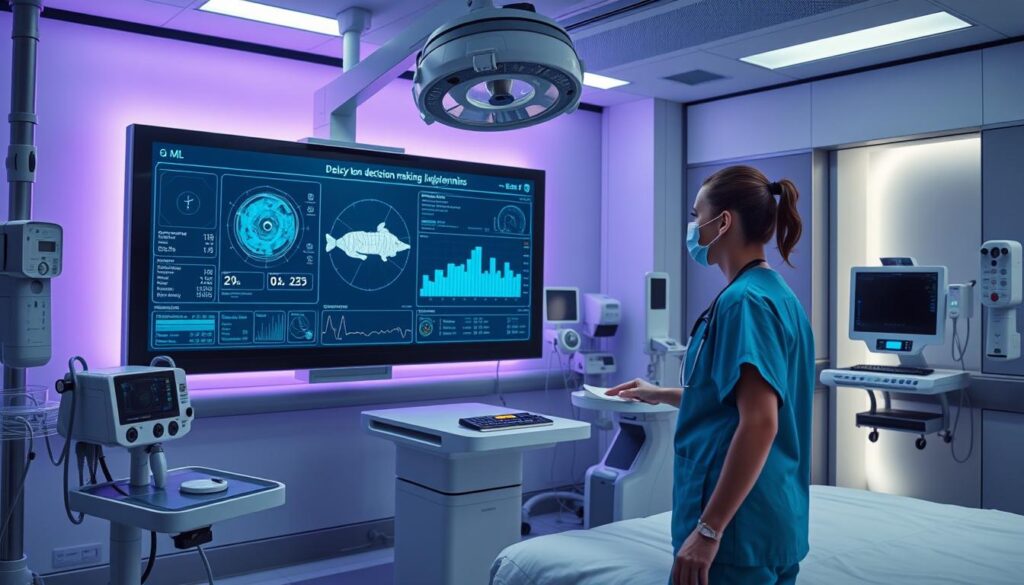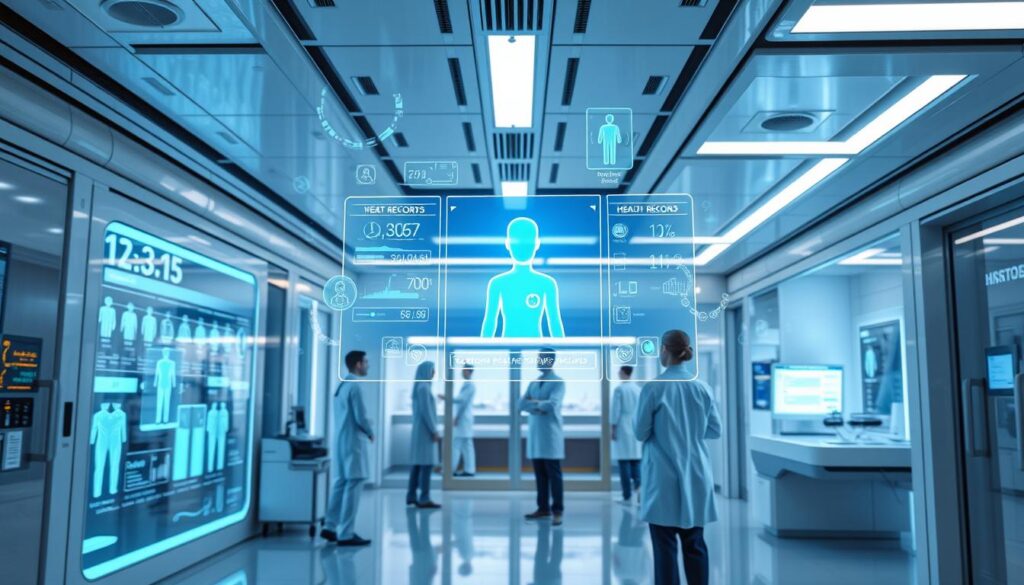The healthcare world has changed a lot thanks to new medical technology. In hospitals, new tech has made patient care better in many ways. It makes things more efficient, safer, and cheaper. Now, almost 5,000 kinds of medical devices help doctors and nurses all over the world.
Old ways of watching over patients are gone, replaced by new tech. For example, pulse oximetry helps find problems early, even before symptoms show. This lets doctors act fast and help patients better. But, new tech also brings new risks and problems. It’s important to think about how it’s made, used, and kept up to make sure it helps patients.
Key Takeaways
- Medical technology has transformed patient care in hospital settings, enhancing efficiency, quality, safety, and cost-effectiveness.
- Nearly 5,000 types of medical devices are used worldwide, impacting various aspects of healthcare delivery.
- Technology has replaced traditional methods of patient monitoring, allowing for earlier detection of changes in patient conditions.
- The implementation of new technologies introduces potential risks and challenges, requiring careful consideration of design, interface, implementation, and maintenance.
- Organizational factors, such as policies, resources, and employee empowerment, play a crucial role in the successful adoption of healthcare technologies.
The Evolution of Medical Technology in Modern Healthcare
The healthcare world has changed a lot in recent years. This change is thanks to new medical technology. Now, we have everything from simple tools to advanced digital tools. These changes have greatly improved how we care for patients and the health outcomes.
From Basic Tools to Advanced Digital Solutions
Medical technology started with basic tools like stethoscopes, X-rays, and penicillin. These tools were a big step forward in diagnosing and treating diseases. But, technology has moved fast, leading to more advanced digital health solutions.
Now, we have electronic health records, telemedicine, and AI tools. These have changed how healthcare works. They make patient care management more efficient and effective.
Impact on Healthcare Delivery Systems
New healthcare technology has made a big difference in hospitals. Wearable sensors, for example, track vital signs and activity. This lets doctors keep a close eye on patients’ health.
Robotic technology has also made surgeries safer and more precise. AI in genomics helps doctors create treatment plans that fit each patient better. This makes care more personalized and efficient.
Current Technological Trends in Hospital Care
The healthcare field is always looking for new tech. Trends like digital twins, IoT, and virtual reality are changing patient care. These new tools improve health outcomes and help healthcare organizations give better care.
Medical technology has been key in changing healthcare. From simple tools to advanced digital solutions, it keeps improving. As technology gets better, it will play an even bigger role in better patient care and health outcomes.
Understanding Clinical Decision Support Systems

Clinical decision support (CDS) systems are key to better patient care in hospitals. They give doctors the right information for each patient. This helps make healthcare safer and better.
One big use of CDS is in computerized patient order entry (CPOE). It helps cut down on mistakes with medicines. This is because it avoids errors from bad handwriting or copying mistakes.
Research shows CPOE can greatly lower mistakes in giving medicines. This makes patient safety better. But, there are still problems like too many alerts and making it easy to use. Fixing these issues is important for CDS to work best in clinical decision-making and medication error reduction.
CDS systems have grown a lot, thanks to AI and ML. Since the 1990s-2000s, linking CDS with electronic health records (EHRs) has become key. It lets doctors see important patient data and insights right when they need it.
- Early CDS systems started in the 1950s-1960s, leading to expert systems in the 1970s-1980s.
- The push for evidence-based medicine in the late 1990s-2000s shaped CDS systems.
- Since the 2010s, AI and ML have made CDS systems much better.
- Mobile health and telemedicine have made CDS more accessible in recent years.
Even though CDS systems are promising, getting them to work well is hard. Issues like keeping data safe, integrating systems, and getting doctors to use them need to be fixed. Working together and keeping researching will help make CDS systems better. This will lead to improved patient safety and enhanced healthcare delivery.
“The implementation of high-quality clinical decision support systems (CDSS) is crucial for healthcare organizations to fully benefit from electronic health records and CPOE.”
Patient Care In Hospital: Digital Transformation of Healthcare Delivery

The healthcare industry is changing fast, thanks to digital technology. This change includes using electronic health records, telemedicine, and AI diagnostics. These tools help manage patient data better, monitor patients remotely, and make diagnoses more accurate.
Electronic Health Records and Patient Data Management
Electronic health records (EHRs) are key in modern healthcare. They make it easy to access patient information and help doctors make better decisions. EHRs help hospitals manage patient data well, cutting down on medical mistakes and improving care.
A study shows 75% of U.S. hospitals use EHRs. This shows the healthcare industry’s big push for digital change.
Telemedicine and Remote Patient Monitoring
Telemedicine and remote monitoring have made healthcare more accessible. They let doctors check on patients without seeing them in person. This is really helpful for people in hard-to-reach areas.
During the COVID-19 pandemic, these tools were especially useful. A survey by Business Wire found 92% of Americans want easy access to their medical records online. This shows how much people value these new ways of getting care.
AI-Powered Diagnostic Tools
AI has changed how doctors diagnose diseases. It helps spot problems early and plan treatments better. AI tools can look at medical images to find issues accurately.
This technology helps doctors make better choices and improves patient care. It leads to quicker and more accurate diagnoses.
The digital change in healthcare is changing how hospitals care for patients. By using EHRs, telemedicine, and AI, hospitals can manage data better, reach more patients, and improve care quality.
“Digital health transformation is highlighted as a critical strategic priority at the European Union level.”
Advanced Patient Monitoring and Safety Technologies
Advanced patient monitoring and safety technologies have changed hospital care a lot. Devices like pulse oximetry help spot changes in patient conditions early. This means doctors can act fast. But, these technologies can also bring new risks.
Also Read : Experience Elite Care at the Top-Ranked Hospital
Studies have found some devices are more likely to cause problems. These include foley catheters, arterial catheters, and central venous catheters.
Using these advanced technologies needs careful thought about how they affect patient safety and care quality. For example, computerized systems that help doctors order medicines have cut down on errors. This has led to fewer bad reactions to medicines in hospitals.
Healthcare providers are making patient monitoring systems better by centralizing them. This move from old systems to new ones helps access more data. It leads to better care and more efficiency.
It’s important to have an open system to use all the data and devices fully. This way, everyone in the health system can get the best information and make better decisions.
FAQs
Q: How does medical technology help improve patient outcomes in hospital settings?
A: Medical technology enhances patient outcomes by enabling more accurate diagnoses, efficient treatment plans, and real-time monitoring, which allows health care providers to respond quickly to changes in a patient’s condition.
Q: What role does the care team play in improving patient care management?
A: The care team, comprising doctors, nurses, and support staff, collaborates to develop and implement individualized care plans that address the unique needs of each patient, thereby improving overall care management and patient satisfaction.
Q: How can technology improve patient safety within health care settings?
A: Technology, such as electronic health records and medication management systems, helps reduce errors, facilitates better communication among care providers, and ensures that patient safety protocols are followed, ultimately leading to higher quality patient care.
Q: In what ways can patient-centered care be enhanced through medical technology?
A: Medical technology can enhance patient-centered care by providing tools for patient engagement, such as mobile apps for health tracking, which allow patients to actively participate in their care and communicate effectively with their health care team.
Q: What is the impact of care management software on quality of patient care?
A: Care management software streamlines processes, improves care coordination, and enables better tracking of patient progress, which collectively contribute to improved quality of patient care and better management of patient needs.
Q: How does technology facilitate pain management in hospital settings?
A: Technology facilitates pain management by providing advanced monitoring systems that assess pain levels more accurately, allowing nursing staff to adjust treatment plans promptly and effectively based on individual patient feedback.
Q: What are some ways to improve patient care quality using health services?
A: Ways to improve patient care quality include implementing evidence-based practices, utilizing telehealth services for better access, and enhancing staff training on patient advocacy and communication skills to ensure that care is provided effectively.
Q: How do health care providers ensure patient engagement during treatment?
A: Health care providers ensure patient engagement by incorporating educational resources, encouraging questions, and soliciting feedback from patients and their families, which fosters a collaborative environment focused on the individual patient’s experience.
Q: What is the significance of quality assurance in health care settings?
A: Quality assurance is crucial in health care settings as it establishes standards and protocols that ensure the delivery of high-quality patient care, enhances patient trust, and improves overall patient outcomes through continuous monitoring and improvement strategies.
Q: How can hospital staff improve patient education to enhance care delivery?
A: Hospital staff can improve patient education by providing clear, accessible information about diagnoses and treatment options, using visual aids, and ensuring that patients understand their care plans, which empowers them to take an active role in their health management.